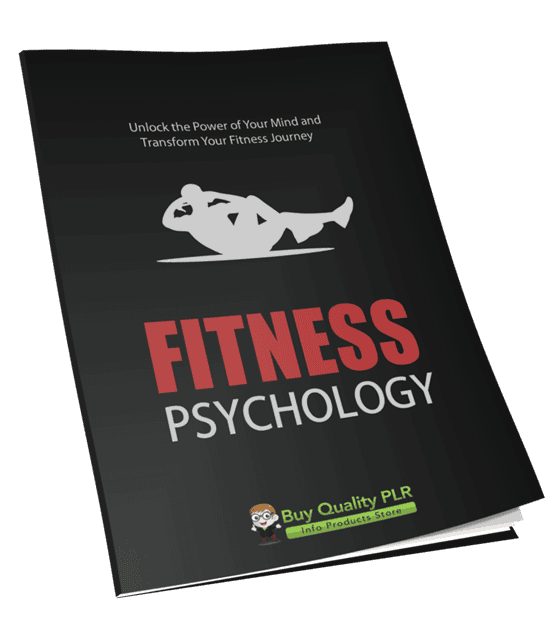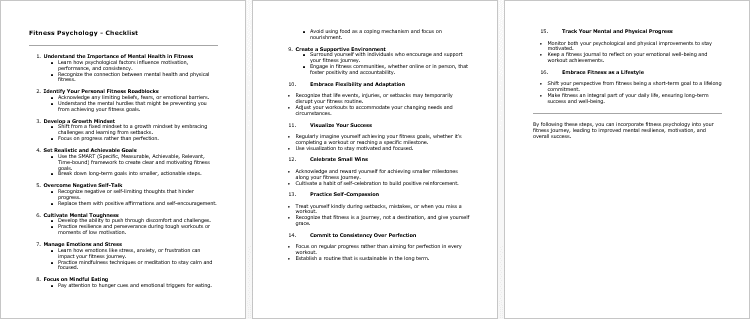
Fitness Psychology PLR Course 25k Words
in Fitness Mindset PLR , Fitness PLR , Fitness PLR Ebooks , PLR eBooks , PLR eCourses , PLR List Building Reports , Premium PLR , Premium PLR eBooks , Premium PLR Reports , Premium White Label Brandable PLR Coaching Courses , Private Label Rights Products , Workout PLR , Workout PLR EbooksChoose Your Desired Option(s)
has been added to your cart!
have been added to your cart!
#fitnesspsychology #mindsetandfitness #plrfitnesscourse #healthandwellnessplr #fitnessmotivation #workoutmindset #privatelabelrights #fitnesscontent #healthymindhealthybody
Fitness Psychology PLR Course – Mastering Your Mind for a Healthier Body
Unlock the Power of Your Mind and Transform Your Fitness Journey
Welcome to the Fitness Psychology PLR Course, a comprehensive guide to unlocking the mental strength you need for achieving your fitness goals. Whether you’re a beginner or looking to level up your fitness game, this course provides the psychological strategies to help you stay motivated, overcome mental barriers, and stay consistent.
In 23,313 words, you’ll explore how your mind influences your fitness journey, and how to harness the power of psychological tools for lasting transformation. Learn to build a strong foundation for fitness success, develop emotional resilience, adopt a growth mindset, and make fitness a permanent part of your life.
This course offers practical insights, actionable steps, and valuable mental frameworks to guide you towards a healthier, fitter version of yourself—mind and body combined!
Presenting…
Fitness Psychology PLR Course 25k Words
Course Overview: Fitness Psychology
The Fitness Psychology PLR Course is designed to provide a holistic approach to fitness, focusing not only on the physical aspects but also on the mental and emotional strategies necessary for sustained success. Through the course, you will learn how to develop a positive mindset, overcome mental roadblocks, create healthy eating habits, build lasting fitness routines, and stay on track for long-term results.
Fitness is often viewed as a series of physical tasks—workouts, meals, and recovery. But the real key to long-term success lies in the mind. By understanding the psychology behind fitness, you’ll be equipped to break through obstacles like lack of motivation, fear of failure, and negative self-talk.
Whether you’re looking to create a fitness plan for yourself or want to create a transformative product for your audience, this course will empower you with the tools needed to understand and master the mental game of fitness.
Course Modules
Module 1: Understanding the Mind-Body Connection
Before diving into the physical exercises, it’s essential to understand how deeply the mind impacts fitness outcomes. In this module, we’ll explore the mind-body connection and how your thoughts, beliefs, and emotions affect your fitness journey.
Key Highlights:
- Step 1: The Power of Your Mind in Fitness
Understand how your mindset impacts your physical performance and consistency. Learn how self-talk, beliefs, and focus affect the results you get in your fitness journey. - Step 2: Rewiring Your Brain for Success
Identify limiting beliefs and negative thought patterns that hinder your fitness progress. Learn actionable steps to rewire your brain for success and create empowering fitness beliefs. - Step 3: The Role of Emotions in Exercise
Emotions are a powerful influence on your fitness habits. Learn how to manage and channel emotions like frustration, stress, and fear to enhance your workouts and performance. - Step 4: Building a Stronger Fitness Identity
Develop a positive fitness identity that aligns with your goals. This step will help you shift from seeing fitness as a chore to embracing it as part of who you are.
Module 2: Overcoming Mental Barriers to Fitness
In this module, you’ll tackle common mental blocks that prevent people from staying consistent with their fitness routine. Whether it’s procrastination, fear of failure, or low self-confidence, you’ll discover strategies to break through these mental barriers.
Key Highlights:
- Step 1: Identifying Your Fitness Roadblocks
Pinpoint the mental obstacles that keep you from achieving your fitness goals. Learn to recognize excuses and negative thought patterns that hold you back. - Step 2: Turning Negative Self-Talk into Motivation
Learn to identify and interrupt negative self-talk. Transform self-criticism into motivation with positive affirmations and powerful mindset shifts. - Step 3: Managing Fear of Failure & Judgment
Fear of failure can be paralyzing. In this step, you’ll learn how to overcome fear and build resilience, so you can move forward with confidence and focus. - Step 4: Breaking Through Plateaus with a Growth Mindset
Fitness plateaus are inevitable, but they don’t have to stop you. Learn how to adopt a growth mindset that allows you to embrace setbacks and use them as opportunities for growth.
Module 3: Building Unstoppable Motivation & Discipline
Motivation is what gets you started, but discipline is what keeps you going. In this module, you’ll learn how to stay motivated long-term, even when your enthusiasm wanes.
Key Highlights:
- Step 1: Finding Your Deeper “Why”
Discover the deeper reasons behind your fitness goals. When you tap into your true motivations, you’ll create a wellspring of lasting motivation that keeps you going through tough times. - Step 2: The Science of Habit Formation
Learn how to build lasting habits that stick. This step covers the psychology behind habit formation and how to create a consistent fitness routine, even when motivation dips. - Step 3: Creating a Fitness Routine You Love
Fitness shouldn’t be a struggle. Learn how to design a fitness routine that aligns with your lifestyle, personality, and energy levels, so you’ll love working out. - Step 4: Developing Mental Toughness for Fitness
Strengthen your mental resilience and learn how to push through challenges. Whether it’s a tough workout or a busy schedule, develop the mental toughness needed to stay on track.
Module 4: The Psychology of Nutrition & Eating Habits
In this module, we’ll explore how your mindset affects your eating habits. Learn how to cultivate a healthier relationship with food, avoid emotional eating, and create a balanced, sustainable approach to nutrition.
Key Highlights:
- Step 1: Understanding Emotional Eating
Learn the psychology behind emotional eating and how to break free from it. Discover strategies to deal with stress, boredom, or sadness without turning to food for comfort. - Step 2: Mindful Eating for Better Results
Mindfulness isn’t just for meditation—it can be applied to eating as well. Discover how to eat mindfully, paying attention to hunger cues, and learning how to enjoy your food without overindulging. - Step 3: Breaking Free from Diet Culture
Diets can often lead to unhealthy relationships with food. Learn how to shift away from restrictive dieting and focus on long-term, sustainable nutrition that fuels your body properly. - Step 4: Fueling Your Mind & Body for Peak Performance
Discover the best foods for energy, focus, and muscle recovery. Learn how to fuel both your body and mind for peak performance during your workouts.
Module 5: Staying Fit for Life – Long-Term Success Strategies
Fitness isn’t just a phase; it’s a lifestyle. In this final module, we’ll cover strategies to help you stay fit for life, regardless of life’s challenges or how busy you get.
Key Highlights:
- Step 1: Setting Realistic & Achievable Goals
Learn how to set SMART fitness goals that are both achievable and motivating. Creating realistic goals ensures long-term success and prevents burnout. - Step 2: Handling Setbacks & Staying Resilient
Setbacks are a natural part of the fitness journey. Learn how to bounce back from a bad week or missed workout without guilt, and how to stay motivated even when things don’t go according to plan. - Step 3: Creating a Support System for Long-Term Success
Surround yourself with a network of like-minded individuals who support and encourage your fitness journey. Learn how to find a fitness community that will help you stay on track. - Step 4: Making Fitness a Lifestyle, Not a Chore
Transform your fitness routine from a task to a lifestyle. Learn how to incorporate fitness seamlessly into your life, so it becomes a natural part of your daily routine.
By the End of This Course, You Will:
- Understand the powerful role your mind plays in achieving your fitness goals.
- Develop a growth mindset that keeps you motivated and focused on long-term success.
- Break through mental and emotional roadblocks that have been holding you back.
- Build a sustainable, realistic fitness routine that you can maintain for life.
- Cultivate a healthier relationship with food and learn how to nourish your body properly.
- Have the tools and mindset needed to stay consistent, motivated, and fit for life.
Bonus Materials
Along with the comprehensive course content, you’ll receive these helpful bonus materials to enhance your learning experience and help you apply the course principles to your own life:
- Fitness Psychology Checklist – 484 words
- Fitness Psychology FAQs – 1,150 words
- Fitness Psychology Salespage – 771 words
How to Profit from This Course
This PLR course isn’t just valuable for personal use; it’s also an excellent business opportunity! Here are several ways you can profit from this course:
- Sell the Content as It Is: Use the course as-is or make minor tweaks to fit your brand, and sell it to others who are looking to transform their fitness mindset.
- Break It Into Smaller Reports: Break the course into smaller, digestible reports and sell them individually for $10-$20 each.
- Bundle with Other Fitness Products: Create a bundle by combining this course with other fitness-related content and sell it for $47-$97.
- Create an Online Course: Use the content to create a multiple-week online course and charge $297-$497 for access.
- Membership Site: Build a membership site offering ongoing fitness psychology content and generate monthly residual payments.
- Physical Products: Convert the content into physical guides or books and sell them for premium prices.
- Convert to Audio/Video: Create an audio or video version of the course and sell it in alternative formats.
- Use for Affiliate Marketing: Promote the course through affiliate marketing and earn commissions for sales.
License Terms
You can use this content for various purposes, but there are some limitations to keep in mind:
What You Can Do:
- Sell the content with minor modifications.
- Break it into smaller reports to sell individually.
- Bundle it with other products for larger sales.
- Create and sell online courses, physical products, or membership sites.
- Convert it to other formats such as audio and video.
What You Cannot Do:
- Pass on PLR rights or resell rights to your customers.
- Offer 100% affiliate commissions.
- Give away the complete content for free (it must be sold).
- Add this content to existing orders without an additional purchase.
Get Started Today!
Are you ready to unlock the power of your mind and achieve your fitness goals? With the Fitness Psychology PLR Course, you’ll be equipped with the mental strategies and tools you need to create lasting fitness success.
Buy Now and start mastering your mind for a healthier, fitter you! 💪
has been added to your cart!
have been added to your cart!
Here A Sample of Fitness Psychology PLR Course
Module 1: Understanding the Mind-Body Connection
Before you can transform your body, you must first understand how your mind influences your fitness journey. This module sets the foundation for long-term success by helping you develop the right mindset.
Step 1: The Power of Your Mind in Fitness
Learn How Thoughts and Beliefs Affect Physical Performance, Motivation, and Consistency
Introduction
The journey to a healthier body begins in the mind. Many people believe that fitness is purely a physical endeavor—one that requires strength, endurance, and willpower. However, scientific research and real-world experiences consistently show that your mindset plays a crucial role in determining how successful you will be in achieving your fitness goals.
Your thoughts and beliefs directly influence your energy levels, motivation, and ability to push through challenges. Whether you want to lose weight, build muscle, or improve endurance, your mental framework will determine your long-term success.
In this step, we will explore:
- How your mindset shapes your fitness journey
- The science behind thoughts influencing physical performance
- How to shift limiting beliefs to unlock your true potential
Let’s dive deep into the psychology of fitness and learn how to train your mind just as you train your body.
1. The Science Behind Mindset and Physical Performance
1.1 The Mind-Muscle Connection
Your brain and body work together to execute every movement, whether lifting weights, running a marathon, or practicing yoga. This connection, known as the mind-muscle connection, is the ability of your brain to actively engage the muscles needed for movement.
- Studies show that visualizing a movement before performing it can increase muscle activation and performance.
- Athletes and professional trainers use mental imagery to enhance their results, imagining themselves successfully completing their workouts before actually doing them.
- Your belief in your ability to complete a task directly impacts your success rate. If you doubt yourself, your body will respond with hesitation and fatigue.
1.2 How Thoughts Influence Motivation
Your thoughts dictate how motivated you feel before and during your workouts. Motivation is not just about wanting to exercise; it is about believing you can do it.
- If you wake up thinking, “I don’t have the energy to work out today,” your brain will send signals that reinforce fatigue, making movement feel harder.
- On the other hand, if you tell yourself, “I will feel great after this workout,” your brain prepares your body for action, increasing your willingness to exercise.
Shifting your inner dialogue can make the difference between skipping a workout and pushing through.
1.3 The Role of Self-Belief in Consistency
The most successful fitness enthusiasts and athletes share a common trait: they believe in their ability to succeed. This belief system influences:
- How quickly they recover from setbacks
- Their ability to stay disciplined even when motivation is low
- Their willingness to challenge themselves beyond their comfort zones
Key takeaway: Your belief system creates a mental blueprint for your success. If you believe fitness is hard, painful, or a burden, your actions will align with those thoughts. If you believe fitness is empowering, rewarding, and essential, you will naturally gravitate toward consistency.
2. Identifying and Overcoming Limiting Beliefs
Your thoughts shape your reality. Many people struggle with fitness because of deeply ingrained limiting beliefs, such as:
- “I am not athletic.”
- “I don’t have time to work out.”
- “I always fail at fitness routines.”
- “I am too old, too busy, or too out of shape to start.”
These beliefs are not facts—they are mental barriers that keep you from achieving your potential.
2.1 How to Identify Limiting Beliefs
- Write down the negative thoughts you have about fitness.
- Ask yourself: Where did these beliefs come from? Were they influenced by past failures, comparisons to others, or societal expectations?
- Challenge each belief: Is this thought objectively true, or is it something you have simply accepted as truth?
2.2 Replacing Limiting Beliefs with Empowering Ones
Once you identify a limiting belief, it is time to reframe it into a positive statement.
- Instead of: “I don’t have time to work out.”
- Say: “I will find small ways to be active, even if it’s just 10 minutes a day.”
- Say: “I will find small ways to be active, even if it’s just 10 minutes a day.”
- Instead of: “I am not athletic.”
- Say: “Every expert was once a beginner. I am improving every day.”
- Say: “Every expert was once a beginner. I am improving every day.”
- Instead of: “I always fail at fitness routines.”
- Say: “I am learning what works best for me, and I am committed to progress.”
Your brain responds to the messages you repeatedly tell yourself. When you replace negative self-talk with empowering beliefs, your actions will follow suit.
3. The Role of Emotional State in Fitness Success
Your emotional state has a direct impact on your workout consistency and performance. Stress, anxiety, and low self-esteem can drain your energy before you even begin.
3.1 How to Shift Your Emotional State Before a Workout
To optimize your mindset before exercising:
✔ Practice deep breathing to calm the mind and prepare for movement.
✔ Use positive visualization—imagine yourself completing the workout with strength and ease.
✔ Listen to energizing music that makes you feel powerful.
✔ Remind yourself of your deeper “why”—your reason for pursuing fitness.
4. Taking Action: Mindset Shifts for Immediate Results
Now that you understand how thoughts and beliefs impact your fitness journey, it’s time to take action.
4.1 Daily Mental Exercises to Strengthen Your Fitness Mindset
Start incorporating these practices into your routine:
- Morning Affirmations: Begin each day by saying out loud:
- “I am strong, capable, and committed to my health.”
- “My body and mind are working together for success.”
- “Every small step forward is a victory.”
- Pre-Workout Visualization: Before starting any exercise, spend 60 seconds imagining yourself completing it successfully.
- Self-Reflection Journal: At the end of each day, write down one positive thought about your fitness progress, no matter how small.
- Surround Yourself with Positivity: Follow social media accounts, podcasts, and communities that promote growth and encouragement rather than comparison.
Conclusion: Training Your Mind is Just as Important as Training Your Body
Your mind is the control center of your fitness journey. By shifting your beliefs, developing empowering thoughts, and using mental strategies, you will:
- Increase motivation and consistency
- Improve physical performance
- Overcome self-doubt and limiting beliefs
- Develop a lifelong fitness mindset
Action Step:
Starting today, commit to one mindset exercise per day. Whether it’s a positive affirmation, a visualization technique, or reframing a negative thought—small mental shifts lead to major physical transformations.
Your fitness journey is not just about what your body can do—it’s about what your mind believes is possible.
Step 2: Rewiring Your Brain for Success
Identify Limiting Beliefs About Fitness and Replace Them with an Empowering Mindset
Introduction
The foundation of long-term fitness success lies not only in the physical work you put in but also in the mental framework you establish. Your beliefs about fitness, your abilities, and even what you deserve, are powerful forces that shape your outcomes. Many individuals struggle in their fitness journey not because they lack physical potential, but because they are held back by limiting beliefs.
These beliefs—often deeply ingrained—can create barriers that prevent you from achieving your fitness goals. The good news is that these beliefs are not fixed. You have the power to rewire your brain and transform your mindset to support your fitness ambitions. This step will guide you through the process of identifying and replacing limiting beliefs with empowering ones, ultimately setting you on a path to lasting success.
1. Understanding Limiting Beliefs and Their Impact
1.1 What Are Limiting Beliefs?
Limiting beliefs are thought patterns or convictions that hold you back from reaching your true potential. In the context of fitness, these beliefs often manifest as:
- “I am not athletic.”
- “I don’t have time to exercise.”
- “I always fail at fitness routines.”
- “I will never lose weight.”
These beliefs may have been shaped by past experiences, societal influences, or negative self-talk. However, they are often false perceptions that limit your ability to act, grow, and succeed.
Example: If you constantly tell yourself, “I am not athletic,” your brain will adopt this thought as reality. As a result, you might avoid activities that challenge you, or your body will physically respond with less effort and energy when you do exercise.
1.2 The Impact of Limiting Beliefs on Fitness
Limiting beliefs can create a self-fulfilling prophecy, where your actions align with the negative beliefs you hold. Some of the consequences include:
- Lack of motivation: Believing you cannot succeed leads to a lack of desire to take action.
- Avoidance of challenges: You may avoid trying new exercises or pushing yourself because you don’t believe you are capable.
- Inconsistent effort: When you don’t think success is possible, your commitment and effort wane over time, leading to an on-again, off-again approach.
- Perfectionism: Holding unrealistic standards can lead to frustration when those standards aren’t met, leading to burnout and quitting.
Key takeaway: Limiting beliefs act as invisible barriers that restrict your potential, often without you even realizing it.
2. Identifying Your Limiting Beliefs
2.1 Self-Reflection: What Do You Believe About Fitness?
The first step in rewiring your brain for success is to become aware of your limiting beliefs. These beliefs are often automatic, and you may not even recognize them as obstacles. Here’s how to uncover them:
- Track Your Thoughts: Start by observing your inner dialogue during or around fitness activities. Whenever you experience resistance, frustration, or avoidance, ask yourself:
- What thoughts are you having right now?
- Are these thoughts empowering or disempowering?
- What negative thoughts frequently pop up when you think about fitness?
- Common Limiting Beliefs in Fitness
Some examples of limiting beliefs in fitness are:
- “I don’t have the genetics for a toned body.”
- “Exercise is too hard, and I will never stick with it.”
- “I’m too old to start working out now.”
- “I don’t have the discipline to be consistent.”
2.2 Journaling Exercise
Write down the following prompts in your journal to help identify your limiting beliefs:
- “When I think about fitness, the first thought that comes to mind is…”
- “I believe I can/cannot achieve (insert fitness goal) because…”
- “The reason I haven’t been consistent with my fitness routine is…”
- “I feel frustrated when I think about (insert fitness challenge) because…”
This process of writing down your thoughts will help you recognize patterns of limiting beliefs and negative self-talk.
3. Replacing Limiting Beliefs with Empowering Ones
3.1 Reframing Negative Thoughts
Once you identify your limiting beliefs, it’s time to reframe them. Reframing is the process of replacing a limiting belief with an empowering alternative. The goal is to transform your inner dialogue into one that supports your fitness goals.
For example:
- Limiting Belief: “I don’t have time to work out.”
- Empowering Belief: “I can find time for short, effective workouts that fit into my schedule.”
- Empowering Belief: “I can find time for short, effective workouts that fit into my schedule.”
- Limiting Belief: “I’m too old to start exercising now.”
- Empowering Belief: “It’s never too late to start. My body can improve at any age.”
- Empowering Belief: “It’s never too late to start. My body can improve at any age.”
- Limiting Belief: “I always fail at sticking to a routine.”
- Empowering Belief: “I am learning to build habits that work for me, and consistency is the key to success.”
To reframe your beliefs, follow these steps:
- Acknowledge the limiting belief.
- Challenge the validity of this belief.
- Replace it with a positive, empowering statement that focuses on what’s possible.
- Repeat the empowering belief regularly to reinforce the new mindset.
3.2 Using Affirmations for Rewiring the Brain
One of the most powerful tools for transforming your beliefs is through affirmations. Repeating positive statements can help reprogram your subconscious mind to align with your fitness goals.
How to Use Affirmations:
- Write down empowering affirmations that directly counter your limiting beliefs.
- For example, if your limiting belief is, “I don’t have the motivation to work out,” your empowering affirmation could be, “I am motivated and excited to work towards my fitness goals every day.”
- Repeat these affirmations daily, especially when you feel doubt creeping in. Say them out loud, write them down, and visualize yourself embodying them.
Over time, these affirmations will retrain your subconscious mind, turning positive beliefs into automatic thought patterns.
4. Cultivating a Growth Mindset for Fitness
4.1 Understanding the Growth Mindset
A growth mindset is the belief that you can develop and improve through dedication, effort, and learning. This mindset is essential for fitness because it empowers you to view challenges as opportunities for growth rather than obstacles.
People with a growth mindset embrace failure as part of the learning process. Instead of thinking, “I can’t do this,” they think, “I can’t do this yet, but I’m improving every day.”
4.2 Adopting a Growth Mindset for Fitness
- Focus on progress, not perfection. Celebrate small victories, whether it’s an extra set completed, improved flexibility, or a more consistent workout routine.
- Embrace challenges as opportunities. Don’t shy away from difficult exercises—see them as chances to learn and grow.
- Learn from setbacks. If you miss a workout or don’t hit a goal, analyze what went wrong and how you can improve next time.
- Believe in your ability to change. Remember, you can always improve your fitness level through hard work, consistency, and patience.
5. Developing Daily Mindset Practices
5.1 Visualization
Visualize your success. Spend a few minutes each day imagining yourself successfully reaching your fitness goals. See yourself performing your workouts with ease, feeling proud of your progress, and enjoying the process. This mental practice will reinforce your empowering beliefs and make them feel more attainable.
5.2 Mindfulness and Self-Compassion
As you continue your fitness journey, practice mindfulness and self-compassion. Recognize when negative thoughts arise and gently challenge them. Treat yourself with kindness, acknowledging that you are learning and growing every step of the way.
Conclusion: Building a Foundation for Long-Term Success
Rewiring your brain for fitness success is not an overnight process. It requires consistent effort and practice, but the rewards are profound. By identifying and replacing limiting beliefs, embracing a growth mindset, and using tools like affirmations and visualization, you will build the mental strength needed to achieve your fitness goals.
Action Step:
Starting today, commit to identifying one limiting belief about fitness and reframe it into an empowering thought. Practice this every day to gradually shift your mindset, and watch your fitness journey transform as a result.
Remember: Your mind is the most powerful tool you have in achieving fitness success. By rewiring it for empowerment, you are setting the stage for lifelong transformation.
Step 3: The Role of Emotions in Exercise
Discover How Emotions Impact Your Energy Levels and Decision-Making in Fitness
Introduction
As international course creators, it is important to understand that emotions play a critical role in determining how we engage with physical activities and maintain long-term fitness goals. Emotions can profoundly influence the way we feel about exercise, how much energy we put into our workouts, and even our ability to make consistent decisions related to our fitness routine.
In this step, we will explore the psychological connection between emotions and exercise, understanding how they impact motivation, energy levels, and decision-making. This insight will enable you to guide your learners in developing a deeper awareness of their emotional state during workouts, teaching them how to use their emotions to their advantage, and learning how to manage negative emotions that may arise during their fitness journey.
1. Understanding the Emotional Connection to Fitness
1.1 How Emotions Affect Your Physical Energy
Emotions are intrinsically tied to our physical state, and this connection can directly influence how we feel during exercise. Positive emotions, such as excitement and joy, tend to boost our energy levels and make exercise feel less taxing. Conversely, negative emotions, such as stress, anxiety, or frustration, can drain us, leading to fatigue, reduced motivation, and avoidance of exercise altogether.
Consider the following emotional scenarios:
- Positive Emotions (Joy, Excitement): When you’re in a good mood or feeling enthusiastic about a fitness challenge, your energy levels are typically higher, making it easier to push through tough workouts. You’re more likely to feel engaged and motivated.
- Negative Emotions (Stress, Sadness, Frustration): These emotions can have the opposite effect, leading to a lack of energy or even the avoidance of exercise. High levels of stress, for example, can lead to physical symptoms such as fatigue or muscle tightness, making exercise feel more difficult.
Emotions create feedback loops that either fuel or hinder your physical performance. The more you understand this connection, the better you can navigate the emotional challenges of fitness.
1.2 The Impact of Emotional States on Performance
- High Energy Emotions: When you feel motivated and excited about working out, your performance will often reflect this emotional state. These feelings increase your adrenaline and endorphin levels, boosting your physical capacity and endurance.
- Low Energy Emotions: On the other hand, when you feel anxious or frustrated, your body might respond by reducing the release of these performance-enhancing hormones. This creates feelings of tiredness or lack of motivation, making it more challenging to perform at your best.
Recognizing the correlation between emotional energy and physical energy will help you better understand how to adjust your approach to fitness when faced with fluctuating emotions.
2. Emotional Triggers in Fitness and Exercise
2.1 Common Emotional Triggers That Impact Workouts
Fitness routines are often impacted by emotional triggers that influence decision-making and workout performance. Some common triggers include:
- Stress and Anxiety: Life stressors, work-related pressures, or personal challenges can trigger emotional responses that reduce your ability to focus or commit to exercise. When stress levels are high, the body produces cortisol, which can lead to feelings of fatigue and make it harder to stay motivated.
- Frustration: Reaching a fitness plateau or struggling to meet goals can create feelings of frustration. This emotion can result in emotional burnout, where the effort required to keep going outweighs the drive to continue.
- Boredom: Monotony in a fitness routine can trigger a lack of interest and make it more difficult to stay committed. Feelings of boredom can reduce energy levels and create a negative association with exercise.
- Lack of Achievement: Not seeing quick results from a workout routine can trigger feelings of failure or discouragement. This can cause individuals to abandon their routines altogether or reduce their efforts.
2.2 Recognizing Emotional Responses During Exercise
Many individuals do not recognize how deeply their emotional states are affecting their workouts. To help course participants manage their emotions, encourage them to identify how they feel before, during, and after exercise. These emotional states can give valuable insight into the barriers or opportunities they may encounter in their fitness journey.
- Before Exercise: Do they feel excited, anxious, or indifferent about the workout?
- During Exercise: Are they motivated, frustrated, or distracted?
- After Exercise: How do they feel physically and emotionally after completing the session? Energized, satisfied, defeated, or exhausted?
Recognizing emotional patterns during fitness activities will help course creators teach their learners how to better manage emotions for optimal energy and consistent motivation.
3. Managing Negative Emotions to Improve Fitness
3.1 Addressing Emotional Blocks
It is essential to address negative emotions head-on so they do not negatively impact fitness routines. Managing these emotions doesn’t mean suppressing them; instead, it involves acknowledging them and transforming their impact on decision-making.
- Cognitive Reframing: When faced with negative emotions like frustration or self-doubt, cognitive reframing can help. This involves changing the narrative around the emotional experience. For example, if you feel frustrated with a lack of progress, try thinking, “This is a temporary setback, and I will keep pushing forward.”
- Mindful Breathing: Breathing exercises can be incredibly effective at regulating emotions. Practicing mindfulness techniques such as deep breathing or meditation before or during a workout can help to center the mind and reduce stress.
- Journaling: Writing about negative emotions related to fitness can help to process those feelings and create a sense of release. This can be especially helpful for course participants who feel overwhelmed or stuck in their fitness routines.
3.2 Emotional Recovery and Self-Compassion
When emotions are overwhelming, it is essential to practice emotional recovery. This means taking the time to acknowledge and release emotional tension before jumping back into exercise.
- Self-Compassion: Encourage learners to practice self-compassion and understand that it’s okay to have bad days. Not every workout has to be perfect. Emphasize that setbacks are part of the process, and it’s important to show themselves understanding and patience when emotions run high.
- Take Breaks When Needed: Sometimes the best way to manage emotions is to take a break and allow the body to rest. This prevents emotional burnout and helps maintain a sustainable fitness routine.
4. Using Positive Emotions to Enhance Exercise Performance
4.1 Creating a Positive Emotional Environment for Exercise
Positive emotions can fuel workouts, providing the motivation and drive needed to achieve goals. Here are a few strategies to create a positive emotional environment around fitness:
- Setting Joyful Goals: Create fitness goals that are both realistic and exciting. When goals are meaningful, they tend to generate positive emotions that can drive motivation.
- Listening to Uplifting Music: Music can have a profound emotional impact. A playlist with upbeat songs can elevate your mood, enhance energy, and make exercise feel more enjoyable.
- Celebrating Small Wins: Celebrate minor achievements, such as an extra set completed or a new personal best. Acknowledging progress creates a sense of achievement and joy, further motivating you to continue your fitness journey.
- Surrounding Yourself with Positivity: Whether it’s a fitness buddy, a positive community, or motivational affirmations, surround yourself with people and things that inspire and uplift you.
4.2 Visualization for Performance Enhancement
Visualization is a powerful technique for promoting positive emotions during exercise. It involves mentally rehearsing workouts, imagining success, and visualizing the positive feelings that come with reaching fitness goals. Visualization can lead to:
- Increased motivation: Seeing yourself succeed in your mind can increase your desire to take action.
- Reduced performance anxiety: Visualization can also help reduce stress or fear around performance, making exercise feel more accessible and less intimidating.
Encourage course participants to set aside time each day to mentally rehearse their workouts and visualize positive emotions such as excitement and pride in their abilities.
5. Developing Emotional Intelligence for Fitness Success
5.1 Building Emotional Awareness
The first step to managing emotions effectively is to become more emotionally aware. Help course participants cultivate emotional intelligence by teaching them to identify and name their feelings, particularly in relation to exercise. Becoming emotionally intelligent can help them understand how their emotions directly affect their behavior and decisions.
5.2 Using Emotional Intelligence to Make Better Fitness Decisions
Emotional intelligence empowers individuals to make better, more thoughtful decisions about their fitness routines. For example, they may recognize when they are pushing themselves too hard due to frustration, or when they need to take a break because they are overwhelmed. It involves balancing emotions to ensure they support—not hinder—fitness progress.
Conclusion: Harnessing the Power of Emotions for Fitness Success
Understanding the role of emotions in fitness is crucial for developing a sustainable and effective exercise routine. Both positive and negative emotions will inevitably arise, but by learning how to manage and channel these feelings, you can significantly improve your energy levels, performance, and long-term commitment to fitness.
As a course creator, you can help participants develop greater emotional resilience, improve their decision-making, and foster a healthy relationship with exercise—one that is fueled by self-awareness, motivation, and emotional intelligence.
Step 4: Building a Stronger Fitness Identity
Shift from “I want to be fit” to “I am a fit person” by aligning your self-image with your goals
Introduction
As international course creators, it is essential to guide learners through a powerful shift in how they see themselves in relation to fitness. Many individuals start their fitness journey with the desire to become fit. They may say, “I want to be fit,” which is a great first step, but it is only the beginning. To achieve long-term success, the key is to internalize the idea of fitness into one’s identity. The shift should be from wanting fitness to becoming fitness.
In this step, we will discuss how to help course participants build a stronger fitness identity by aligning their self-image with their fitness goals. By doing so, they will not just desire fitness—they will embody it in every aspect of their lives. This transformation will foster confidence, self-efficacy, and consistency, all of which are crucial to achieving sustainable fitness success.
1. The Power of Identity in Fitness
1.1 Understanding the Role of Self-Image
Our identity is how we perceive ourselves. It is the mental image we hold about who we are, and it influences every decision and action we take. When it comes to fitness, the way we see ourselves directly affects our ability to commit to goals, persevere through challenges, and embrace consistent action.
For example, someone who views themselves as a “fit person” will naturally engage in behaviors that support their identity, such as exercising regularly, choosing healthy foods, and prioritizing their physical well-being. In contrast, someone who sees themselves as an “unfit person” might struggle with motivation and consistency, as they view fitness as something they need to achieve, rather than something that is already part of their identity.
The key takeaway here is that identity shapes behavior. If you want lasting changes in fitness, it is essential for your course participants to start by shifting their self-image to align with the goals they want to achieve.
1.2 The Self-Fulfilling Prophecy
The concept of the self-fulfilling prophecy plays a crucial role in fitness identity. If individuals continually tell themselves, “I am not a fit person,” they may inadvertently reinforce this belief through their actions, resulting in a cycle of failure or lack of effort. On the other hand, by adopting the belief, “I am a fit person,” they are more likely to take actions that align with this belief, such as working out regularly, making healthy food choices, and prioritizing their physical well-being.
This cycle works both ways: positive identity beliefs lead to positive behaviors, which reinforce a stronger fitness identity. By helping learners reframe their mindset, you can guide them to establish a foundation for success.
2. How to Shift Your Self-Image to Align with Fitness Goals
2.1 Visualizing the “Fit You”
Visualization is a powerful technique used to transform the way you see yourself. In this step, guide your course participants to visualize their ideal fitness identity. This is not about wishing or fantasizing—it’s about creating a clear and detailed mental image of the person they are striving to become.
Exercise: Guided Visualization
- Set the Scene: Ask participants to close their eyes, take a deep breath, and imagine themselves as the most fit version of themselves. Encourage them to make this vision as vivid as possible: What do they look like? How do they feel in their body? What activities do they enjoy doing?
- Embody the Vision: Have them imagine going through their day as a fit person. How does their energy feel? What kinds of food do they choose? What time do they wake up for a workout? How do they talk about fitness to others?
- Connect with Emotions: Encourage participants to connect with the positive emotions associated with their fit self—whether it’s confidence, empowerment, strength, or pride.
By repeatedly visualizing themselves as fit, participants will begin to integrate this image into their self-identity, making it more likely they will take consistent actions toward becoming that person.
2.2 Affirmations and Positive Self-Talk
To solidify the transformation in their self-image, learners can use affirmations and positive self-talk. These are statements that reinforce the belief that they are already a fit person, even if they haven’t fully achieved their goal yet. Affirmations work by reprogramming the subconscious mind to align with new, empowering beliefs.
Examples of powerful fitness affirmations include:
- “I am a fit and healthy person.”
- “I make choices that support my fitness goals.”
- “I am strong, capable, and committed to my health.”
- “Fitness is a natural part of who I am.”
Encourage participants to use these affirmations daily—whether it’s while looking in the mirror, journaling, or repeating them silently during a workout. Repetition is key to making the new identity feel real and empowering.
2.3 Setting Identity-Based Goals
Another critical aspect of aligning self-image with fitness goals is to set identity-based goals. Traditional goals are often focused on external achievements, like losing weight or lifting a certain amount of weight. While these are important, they focus on the outcome rather than the transformation of self.
Instead, encourage learners to set identity-based goals that emphasize who they want to become, not just what they want to achieve. For example, rather than saying, “I want to lose 10 pounds,” encourage them to reframe the goal as, “I am a person who makes healthy choices every day.” This places the emphasis on the identity shift rather than the external result, making it more sustainable and fulfilling.
Other identity-based goals might include:
- “I am someone who exercises regularly and enjoys it.”
- “I am a person who prioritizes my health and well-being.”
- “I am committed to continuous growth and improvement in my fitness journey.”
This approach helps learners integrate their fitness goals into their daily actions, gradually reinforcing the identity they are working to build.
3. Overcoming the Challenges of Identity Shifts
3.1 Dealing with Setbacks and Negative Thoughts
When participants begin shifting their identity, it’s normal to encounter setbacks or negative thoughts. For example, they may experience a challenging workout or fall short of their fitness goal, which could lead them to question their new identity. During these moments, it is crucial to remind them that identity is not about perfection—it’s about consistency and resilience.
Teach learners how to bounce back from setbacks by:
- Reframing failure: Encourage them to see challenges as learning opportunities, not as indications of their inability to succeed.
- Practicing self-compassion: Help them recognize that mistakes are a part of the process and that self-criticism only hinders progress.
- Focusing on progress: Remind them that every step forward, no matter how small, brings them closer to becoming the fit person they aspire to be.
3.2 Building Consistency and Patience
Shifting your identity takes time and consistent effort. It’s not something that happens overnight, and it requires patience. Encourage learners to stay committed to their new identity by:
- Taking small actions that align with their fitness identity every day, such as getting a workout in or choosing a healthy meal.
- Tracking progress in ways that go beyond just physical appearance—such as increased energy, improved mood, or better stamina.
- Celebrating small wins, which help to reinforce the belief that they are becoming a fit person.
Encourage learners to see their fitness journey as a long-term commitment to becoming the best version of themselves.
4. Reinforcing Your New Fitness Identity Daily
4.1 Creating a Daily Routine That Supports Your Fitness Identity
Once participants have started shifting their fitness identity, the next step is to create a daily routine that supports this new identity. This routine should be rooted in consistency and alignment with their identity-based goals.
For example:
- Start the day with a positive affirmation or visualization to remind themselves of their identity as a fit person.
- Include time for exercise, mindful eating, and self-care activities that nurture the body and mind.
- Reflect on how each action aligns with their new identity, reinforcing the belief that they are indeed a fit person.
4.2 Surrounding Yourself with Support
Lastly, encourage learners to surround themselves with people and environments that support their fitness identity. This could mean joining a fitness community, engaging with friends who share similar goals, or following social media accounts that inspire and motivate them to stay consistent.
By embedding fitness into their social circles and surroundings, learners will find it easier to adopt and reinforce their new identity.
Conclusion: Becoming a Fit Person, Not Just Wanting to Be Fit
The shift from “I want to be fit” to “I am a fit person” is not just a mental exercise—it is the foundation of lasting change. By aligning their self-image with their fitness goals, learners will no longer view fitness as something external to themselves, but as a core part of their identity. This transformation will enable them to stay consistent, overcome challenges, and experience long-term success.
As course creators, your role is to guide participants through this transformative process, helping them integrate fitness into their identity in a sustainable and empowering way.
We’re also giving these extra bonuses
Fitness Psychology – Checklist

Fitness Psychology – FAQs

Fitness Psychology – Salespage Content

Package Details:
Word Count: 23 313 Words
Number of Pages: 96
Fitness Psychology – Bonus Content
Checklist
Word Count: 484 words
FAQs
Word Count: 1150 words
Salespage Content
Word Count: 771 words
Total Word Count: 25 718 Words
Your PLR License Terms
PERMISSIONS: What Can You Do With These Materials?
Sell the content basically as it is (with some minor tweaks to make it “yours”).
If you are going to claim copyright to anything created with this content, then you must substantially change at 75% of the content to distinguish yourself from other licensees.
Break up the content into small portions to sell as individual reports for $10-$20 each.
Bundle the content with other existing content to create larger products for $47-$97 each.
Setup your own membership site with the content and generate monthly residual payments!
Take the content and convert it into a multiple-week “eclass” that you charge $297-$497 to access!
Use the content to create a “physical” product that you sell for premium prices!
Convert it to audios, videos, membership site content and more.
Excerpt and / or edit portions of the content to give away for free as blog posts, reports, etc. to use as lead magnets, incentives and more!
Create your own original product from it, set it up at a site and “flip” the site for megabucks!
RESTRICTIONS: What Can’t You Do With These Materials?
To protect the value of these products, you may not pass on the rights to your customers. This means that your customers may not have PLR rights or reprint / resell rights passed on to them.
You may not pass on any kind of licensing (PLR, reprint / resell, etc.) to ANY offer created from ANY PORTION OF this content that would allow additional people to sell or give away any portion of the content contained in this package.
You may not offer 100% commission to affiliates selling your version / copy of this product. The maximum affiliate commission you may pay out for offers created that include parts of this content is 75%.
You are not permitted to give the complete materials away in their current state for free – they must be sold. They must be excerpted and / or edited to be given away, unless otherwise noted. Example: You ARE permitted to excerpt portions of content for blog posts, lead magnets, etc.
You may not add this content to any part of an existing customer order that would not require them to make an additional purchase. (IE You cannot add it to a package, membership site, etc. that customers have ALREADY paid for.)
Share Now!












